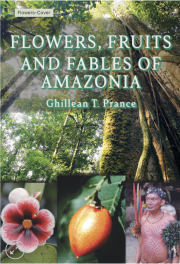Flowers, Fruits and Fables of Amazonia

Ghillean T. Prance
Redfern Natural History Productions, £25.00
Tropical forests, and especially those of Amazonia, have always been of primary importance in the scientific world, but recent focus on global warming has brought them to the attention of most global citizens. This book is a timely addition to the literature because it addresses a range of forest community characteristics. These include details of ecosystem composition and function of the largest tropical forest in the world as well as information on the history, uses and applications of individual plant species.
Much of the latter originates from the historical and present use by indigenous peoples. Notably, some species are a food source e.g. fruits such as the papaya and nectarine, and nuts such as the cashew. There are also species which provide dyes, such as the genipapo, while others have medicinal uses (e.g. the cinchona tree which is the source of quinine). Others, such as the piassaba palm, provide fibre used for arts and crafts locally and abroad. Many plant species also underpin legends and folklore as exemplified by guarana, a plant rich in caffeine whose seeds are often used as a stimulant, and which is considered to have originated from the eyes of an ancient young prince following his death.
The copious and engaging information is presented using botanical groups i.e. pteridophytes (ferns), gymnosperms (cone bearers), monocotyledons, and dicotyledons. The first two groups have relatively few members, while the latter two dominate, especially the dicotyledons. Throughout there are abundant eye-catching coloured photographs with details of species, and their uses where appropriate, plus location and dominant environmental conditions.
The approachable and accessible – but surprisingly mapless – text is followed by a bibliography, glossary and details of nine charities that aim to protect the rainforests. A brief CV of the author reflects his long-term contribution to understanding Amazon ecology and vital reference details follow: index to scientific names, index to local names, and a general index.
Attractive, inspirational, and remarkable, this book is well-priced, making it accessible to a wide range of interested readers. Well done to all those involved in its production and promotion.
Dr A M Mannion
Reviewed by Dr A M Mannion, Honorary Fellow at the University of Reading Department of Geography


